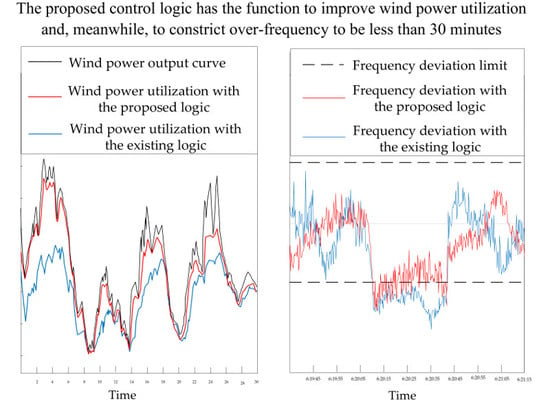A New Control Logic for a Wind-Area on the Balancing Authority Area Control Error Limit Standard for Load Frequency Control
Abstract
:1. Introduction
2. Analysis on the BAAL Standard
2.1. Description of the Standard
2.2. Interpretation of the Standard
2.2.1. Purpose of the Standard
2.2.2. Characteristics of the Standard
- Dynamic BAAL related to frequency. BAAL changes with actual frequency deviation. A larger absolute value of frequency deviation brings a smaller BAAL for the ACE. When the ACE has a different sign with frequency deviation, it is beneficial for maintaining frequency quality. In this case, the size of the ACE would not be restricted. This philosophy fits the requirement of secure and economic operation.
- Different requirements for different areas. Different requirements for ACEs mean different regulation responsibilities of areas. determines different areas’ BAALs at the same frequency deviation. From (3), an area with a smaller would be assigned a stricter requirement, because frequency is more sensitive to its ACE.
- Permitting correlations between ACEs. If each area’s clock-minute average of reported ACE is within its BAAL, no matter whether or not there are correlations between ACEs, the clock-minute average of frequency deviation can be maintained within the range from to . When the duration of each over-limit ACE is less than 30 min, the duration of over-limit frequency would not be more than 30 min. By contrast, in the CPS2 design, it is assumed that there is no correlation between different ACEs [12]. However, correlations indeed exist in an actual grid. So, the BAAL Standard is more practical than the CPS2 on this point.
3. Proposed Control Logic
3.1. Design Philosophy
3.2. Triggered Monitoring
3.3. Graded Regulation
3.4. Cooperation with CPS1 Control Logic
4. Simulation Test
4.1. Test Conditions
4.2. Test Results
4.2.1. Wind Power Utilization
4.2.2. Over-Limit Frequency and Over-Limit ACE
4.2.3. Regulation on ACE of the BAL-001-2 Logic
5. Conclusions
Acknowledgments
Author Contributions
Conflicts of Interest
References
- Pandey, S.K.; Mohanty, S.R.; Kishor, N. A literature survey on load–frequency control for conventional and distribution generation power systems. Renew. Sustain. Energy Rev. 2013, 25, 318–334. [Google Scholar] [CrossRef]
- Rosyiana, F.I.; Kim, J.S.; Song, H. High-Gain Disturbance Observer-Based Robust Load Frequency Control of Power Systems with Multiple Areas. Energies 2017, 10, 595. [Google Scholar] [CrossRef]
- Ersdal, A.M.; Imsland, L.; Uhlen, K. Model predictive load-frequency control. IEEE Trans. Power Syst. 2016, 31, 777–785. [Google Scholar] [CrossRef]
- Liu, Y.; Gao, S.; Zhao, X.; Zhang, N. Coordinated Operation and Control of Combined Electricity and Natural Gas Systems with Thermal Storage. Energies 2017, 10, 917. [Google Scholar] [CrossRef]
- Wen, G.; Hu, G.; Hu, J.; Chen, G. Frequency regulation of source-grid-load systems: A compound control strategy. IEEE Trans. Ind. Inform. 2016, 12, 69–78. [Google Scholar] [CrossRef]
- Ahumada, C.; Cárdenas, R.; Sáez, D.; Guerrero, J.M. Secondary control strategies for frequency restoration in islanded microgrids with consideration of communication delays. IEEE Trans. Smart Grid 2016, 7, 1430–1441. [Google Scholar] [CrossRef]
- Ba, Y.; Liu, R.; Li, W. Comparison of CPS and its assessment between North America and China. Autom. Electr. Power Syst. 2012, 36, 63–72. (In Chinese) [Google Scholar]
- Maruejouls, N.; Margotin, T.; Trotignon, M.; Dupuis, P.L.; Tesseron, J.M. Measurement of the load frequency control system service: Comparison between American and European indicators. IEEE Trans. Power Syst. 2002, 15, 1382–1387. [Google Scholar] [CrossRef]
- Moghadam, M.F.; Dunford, W.G.; Vaahedi, E.; Metcalfe, M. Evaluation of NERC’s BRD frequency control standard in hydroelectric generation. In Proceedings of the Power & Energy Society General Meeting, Denver, CO, USA, 26–30 July 2015; pp. 1–5. [Google Scholar] [CrossRef]
- Jaleeli, N.; VanSlyck, L.S. NERC’s new control performance standards. IEEE Trans. Power Syst. 1999, 14, 1092–1099. [Google Scholar] [CrossRef]
- Steinmetz, W.K.; Cole, J.D. Sampling ACE data for NERC CPC surveys. IEEE Comput. Appl. Power 1993, 6, 27–32. [Google Scholar] [CrossRef]
- Jaleeli, N.; VanSlyck, L.S. Control Performance Standards and Procedures for Interconnected Operation; Technical Report TR-107813; Electric Power Research Institute: Palo Alto, CA, USA, 1997. [Google Scholar]
- BAL-001-2—Real Power Balancing Control Performance Standard Background Document. Available online: http://www.nerc.com/pa/Stand/Project%202010141%20%20Phase%201%20of%20Balancing%20Authority%20Re/BAL-001-2_Background_%20Document-Clean-20130701.pdf (accessed on 7 November 2017).
- Frequency Control Performance Measurement and Requirements. Available online: http://escholarship.org/uc/item/2d63w2f7 (accessed on 7 November 2017).
- Etingov, P.V.; Makarov, Y.V.; Samaan, N.; Ma, J.; Loutan, C.; Rothleder, M.; Chowdhury, S. Prediction of regulation reserve requirements in california ISO balancing authority area based on BAAL. In Proceedings of the Power and Energy Society General Meeting, Vancouver, BC, Canada, 21–25 July 2013; pp. 1–5. [Google Scholar] [CrossRef]
- Balancing Authority ACE Limit (BAAL) Preliminary Field Trial Report. Available online: http://www.nerc.com/FilingsOrders/us/NERC%20Filings%20to%20FERC%20DL/Transmittal_letter_Field%20Trial%20Report.pdf (accessed on 7 November 2017).
- Reliability Standards for the Bulk Electric Systems of North America. Available online: http://www.nerc.com/pa/Stand/Reliability%20Standards%20Complete%20Set/RSCompleteSet.pdf (accessed on 7 November 2017).
- Rerkpreedapong, D.; Hasanovic, A.; Feliachi, A. Robust load frequency control using genetic algorithms and linear matrix inequalities. IEEE Trans. Power Syst. 2003, 18, 855–861. [Google Scholar] [CrossRef]
- Yu, T.; Zhou, B. A novel self-tuning CPS controller based on Q-learning method. In Proceedings of the Power and Energy Society General Meeting, Pittsburgh, PA, USA, 20–24 July 2008; pp. 1–6. [Google Scholar] [CrossRef]
- Merk, B.; Litskevich, D.; Whittle, K.R.; Bankhead, M.; Taylor, R.J.; Mathers, D. On a Long Term Strategy for the Success of Nuclear Power. Energies 2017, 10, 867. [Google Scholar] [CrossRef]
- Elamalayil, S.D.; Leijon, M. Cross-Regulation Assessment of DIDO Buck-Boost Converter for Renewable Energy Application. Energies 2017, 10, 846. [Google Scholar] [CrossRef]
- Cong, P.; Tang, W.; Zhang, L.; Zhang, B.; Cai, Y. Day-Ahead Active Power Scheduling in Active Distribution Network Considering Renewable Energy Generation Forecast Errors. Energies 2017, 10, 1291. [Google Scholar] [CrossRef]
- Weitemeyer, S.; Kleinhans, D.; Vogt, T.; Agert, C. Integration of Renewable Energy Sources in future power systems: The role of storage. Renew. Energy 2015, 75, 14–20. [Google Scholar] [CrossRef]
- Kaplan, Y.A. Overview of wind energy in the world and assessment of current wind energy policies in Turkey. Renew. Sustain. Energy Rev. 2015, 43, 562–568. [Google Scholar] [CrossRef]
- Liu, Y.; Ren, L.; Li, Y.; Zhao, X. The industrial performance of wind power industry in China. Renew. Sustain. Energy Rev. 2015, 43, 644–655. [Google Scholar] [CrossRef]
- Higgins, P.; Foley, A. The evolution of offshore wind power in the United Kingdom. Renew. Sustain. Energy Rev. 2014, 37, 599–612. [Google Scholar] [CrossRef]
- François, B.; Martino, S.; Tøfte, L.S.; Hingray, B.; Mo, B.; Creutin, J. Effects of Increased Wind Power Generation on Mid-Norway’s Energy Balance under Climate Change: A Market Based Approach. Energies 2017, 10, 227. [Google Scholar] [CrossRef]
- Global Wind Report. 2016. Available online: https://www.researchgate.net/p-ublication/316699909_Global_Wind_Report_2016_-_Annual_Market_Update (accessed on 7 November 2017).
- Dimov, A.; Bolik, S. Wind turbine manufacturers observation regarding reactive power support and control requirements. IET Renew. Power Gener. 2017, 11, 539–544. [Google Scholar] [CrossRef]
- Kane, L.; Ault, G.W. Evaluation of wind power curtailment in active network management schemes. IEEE Trans. Power Syst. 2015, 30, 672–679. [Google Scholar] [CrossRef]
- Fan, X.; Wang, W.; Shi, R.; Li, F. Analysis and countermeasures of wind power curtailment in China. Renew. Sustain. Energy Rev. 2015, 52, 1429–1436. [Google Scholar] [CrossRef]
- Burke, D.J.; O’Malley, M.J. Factors influencing wind energy curtailment. IEEE Trans. Sustain. Energy 2011, 2, 185–193. [Google Scholar] [CrossRef]
- Gu, Y.; Xie, L.; Rollow, B.; Hesselbaek, B. Congestion-induced wind curtailment: Sensitivity analysis and case studies. In Proceedings of the North American Power Symposium, Boston, MA, USA, 4–6 August 2011; pp. 1–7. [Google Scholar] [CrossRef]
- Jacobsen, H.K.; Schröder, S.T. Curtailment of renewable generation: Economic optimality and incentives. Energy Policy 2012, 49, 663–675. [Google Scholar] [CrossRef] [Green Version]
- Martín-Martínez, S.; Gómez-Lazaro, E.; Molina-Garcia, A.; Honrubia-Escribano, A. Impact of wind power curtailments on the Spanish power system operation. In Proceedings of the PES General Meeting|Conference & Exposition, National Harbor, MD, USA, 27–31 July 2014; pp. 1–5. [Google Scholar] [CrossRef]
- Luo, G.L.; Li, Y.L.; Tang, W.J.; Wei, X. Wind curtailment of China’s wind power operation: Evolution, causes and solutions. Renew. Sustain. Energy Rev. 2016, 53, 1190–1201. [Google Scholar] [CrossRef]
- Xiong, W.; Wang, Y.; Mathiesen, B.V.; Zhang, X. Case study of the constraints and potential contributions regarding wind curtailment in Northeast China. Energy 2016, 110, 55–64. [Google Scholar] [CrossRef]
- Garrigle, E.V.M.; Deane, J.P.; Leahy, P.G. How much wind energy will be curtailed on the 2020 Irish power system? Renew. Energy 2013, 55, 544–553. [Google Scholar] [CrossRef]
- Mckenna, E.; GrüNewald, P.; Thomson, M. Going with the wind: Temporal characteristics of potential wind curtailment in Ireland in 2020 and opportunities for demand response. IET Renew. Power Gener. 2015, 9, 66–77. [Google Scholar] [CrossRef]
- Alessandrini, S.; Sperati, S.; Pinson, P. A comparison between the ECMWF and COSMO Ensemble Prediction Systems applied to short-term wind power forecasting on real data. Appl. Energy 2013, 107, 271–280. [Google Scholar] [CrossRef]
- Dvorkin, Y.; Lubin, M.; Backhaus, S.; Chertkov, M. Uncertainty sets for wind power generation. IEEE Trans. Power Syst. 2016, 31, 3326–3327. [Google Scholar] [CrossRef]
- Bessa, R.J.; Miranda, V.; Botterud, A.; Wang, J.; Constantinescu, E.M. Time adaptive conditional kernel density estimation for wind power forecasting. IEEE Trans. Sustain. Energy 2012, 3, 660–669. [Google Scholar] [CrossRef]
- Wan, C.; Xu, Z.; Pinson, P.; Dong, Z.; Wong, K. Probabilistic forecasting of wind power generation using extreme learning machine. IEEE Trans. Power Syst. 2014, 29, 1033–1044. [Google Scholar] [CrossRef]
- Constantinescu, E.M.; Zavala, V.M.; Rocklin, M.; Lee, S.; Anitescu, M. A computational framework for uncertainty quantification and stochastic optimization in unit commitment with wind power generation. IEEE Trans. Power Syst. 2011, 26, 431–441. [Google Scholar] [CrossRef]
- Wan, C.; Lin, J.; Wang, J.; Song, Y.; Dong, Z. Direct quantile regression for nonparametric probabilistic forecasting of wind power generation. IEEE Trans. Power Syst. 2017, 32, 2767–2778. [Google Scholar] [CrossRef]
- Ackermann, T. Wind Power in Power Systems, 2rd ed.; John Wiley & Sons Ltd.: New York, NY, USA, 2012. [Google Scholar]
- Bianchi, F.D.; Mantz, R.J.; De Battista, H. The Wind and Wind Turbines; Springer: London, UK, 2007; pp. 7–28. [Google Scholar]
- Liu, J.; Wang, X.; Lu, Y. A novel hybrid methodology for short-term wind power forecasting based on adaptive neuro-fuzzy inference system. Renew. Energy 2017, 103, 620–629. [Google Scholar] [CrossRef]
- Fang, S.; Chiang, H.D. A high-accuracy wind power forecasting model. IEEE Trans. Power Syst. 2017, 32, 1589–1590. [Google Scholar] [CrossRef]
- Jallad, J.; Mekhilef, S.; Mokhlis, H. Frequency Regulation Strategies in Grid Integrated Offshore Wind Turbines via VSC-HVDC Technology: A Review. Energies 2017, 10, 1244. [Google Scholar] [CrossRef]
- Arani, M.F.M.; Mohamed, Y.A.R.I. Analysis and Damping of Mechanical Resonance of Wind Power Generators Contributing to Frequency Regulation. IEEE Trans. Power Syst. 2017, 32, 3195–3204. [Google Scholar] [CrossRef]
- Alves, R.; Reis, F.S.; Shen, H. Wind power curtailment optimization for day-ahead operational planning. In Proceedings of the PES Innovative Smart Grid Technologies Conference Europe (ISGT-Europe), Ljubljana, Slovenia, 9–12 October 2016; pp. 1–6. [Google Scholar] [CrossRef]
- Waite, M.; Modi, V. Modeling wind power curtailment with increased capacity in a regional electricity grid supplying a dense urban demand. Appl. Energy 2016, 183, 299–317. [Google Scholar] [CrossRef]
- Supporting Document for the Network Code on Load-Frequency Control and Reserves. Available online: https://www.entsoe.eu/fileadmin/user_upload/_library/resources/LCFR/130628-NC_LFCR-Supporting_Document-Issue1.pdf (accessed on 7 November 2017).
- Network Code on Load-Frequency Control and Reserves. Available online: https://www.entsoe.eu/fileadmin/user_upload/_library/resources/LCFR/130628-NC_LFCR-Issue1.pdf (accessed on 7 November 2017).
- Tan, C.; Dai, Z.; Teng, X.; Gao, Z. Development of Frequency Control Performance Standard in North America and Its Enlightenment to China. Autom. Electr. Power Syst. 2015, 39, 1–7. [Google Scholar] [CrossRef]
- Chang, Y.; Liu, R.; Ba, Y.; Li, W. Analysis of Balancing Authority ACE Limit Standard of North America. Power Syst. Technol. 2016, 1, 256–262. [Google Scholar] [CrossRef]
- Underfrequency Load Shedding Assessment Report. Available online: https://www.wecc.biz/Reliability/UFLSRG (accessed on 7 November 2017).
- IEEE Guide for Abnormal Frequency Protection for Power Generating Plants. Available online: http://ieeexplore.ieee.org/document/1270518/ (accessed on 7 November 2017).
- Walling, R.A.; Miller, N.W. Distributed generation islanding-implications on power system dynamic performance. In Proceedings of the Power Engineering Society Summer Meeting, Chicago, IL, USA, 21–25 July 2002; pp. 92–96. [Google Scholar] [CrossRef]
- Anderson, P.M.; Mirheydar, M. An adaptive method for setting underfrequency load shedding relays. IEEE Trans. Power Syst. 1992, 7, 647–655. [Google Scholar] [CrossRef]
- Aho, J.; Buckspan, A.; Laks, J.; Fleming, P.; Jeong, Y.; Dunne, F.; Churchfield, M.; Pao, L.; Johnson, K. A tutorial of wind turbine control for supporting grid frequency through active power control. In Proceedings of the American Control Conference, Montreal, QC, Canada, 27–29 June 2012; pp. 3120–3131. [Google Scholar] [CrossRef]
- Rawn, B.G.; Lehn, P.W.; Maggiore, M. Control methodology to mitigate the grid impact of wind turbines. IEEE Trans. Energy Convers. 2007, 22, 431–438. [Google Scholar] [CrossRef]
- Tarnowski, G.C.; Kjær, P.C.; Dalsgaard, S.; Nyborg, A. Regulation and frequency response service capability of modern wind power plants. In Proceedings of the Power & Energy Society General Meeting, Providence, RI, USA, 25–29 July 2010; pp. 1–8. [Google Scholar] [CrossRef]
- Dvorkin, Y.; Ortega-Vazuqez, M.A.; Kirschen, D.S. Wind generation as a reserve provider. IET Gener. Transm. Distrib. 2015, 9, 779–787. [Google Scholar] [CrossRef]
- Yao, M.; Shoults, R.R.; Kelm, R. AGC logic based on NERC’s new Control Performance Standard and Disturbance Control Standard. IEEE Trans. Power Syst. 2000, 15, 852–857. [Google Scholar] [CrossRef]
- Wu, S.S.J.; Chang-Chien, L.R.; Lee, W.J.; Lu, C.N.; Chang, R.F.; Wu, C.C.; Lan, H.W. Redesign of frequency controls for CPS evaluations in an isolated power system. In Proceedings of the Power and Energy Society General Meeting, Providence, RI, USA, 25–29 July 2010; pp. 1–6. [Google Scholar] [CrossRef]
- Ba, Y.; Li, W. A simulation scheme for AGC relevant studies. IEEE Trans. Power Syst. 2013, 28, 3621–3628. [Google Scholar] [CrossRef]
- Yi, H.; Cheng, S.; Du, Z.; Shi, L.; Ni, Y. Modeling and simulation on long-term dynamics of interconnected power system using area COI concept. Electr. Power Syst. Res. 2008, 78, 1369–1377. [Google Scholar] [CrossRef]
- Zhang, N. Multi-Cycle Unit Commitment Coping with High Wind Power Uncertainty. Ph.D. Thesis, Dalian University of Technology, Dalian, China, June 2014. [Google Scholar]
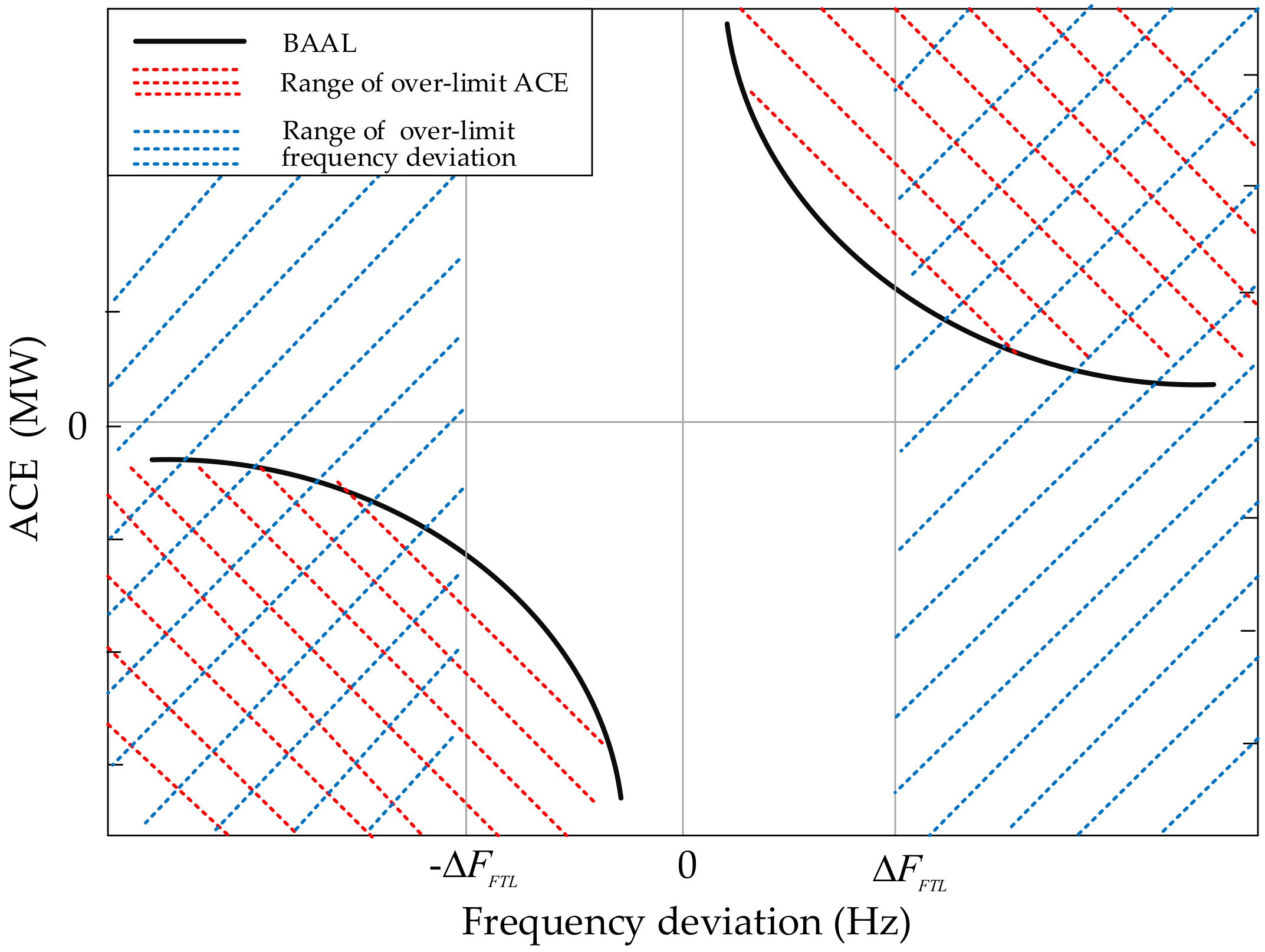
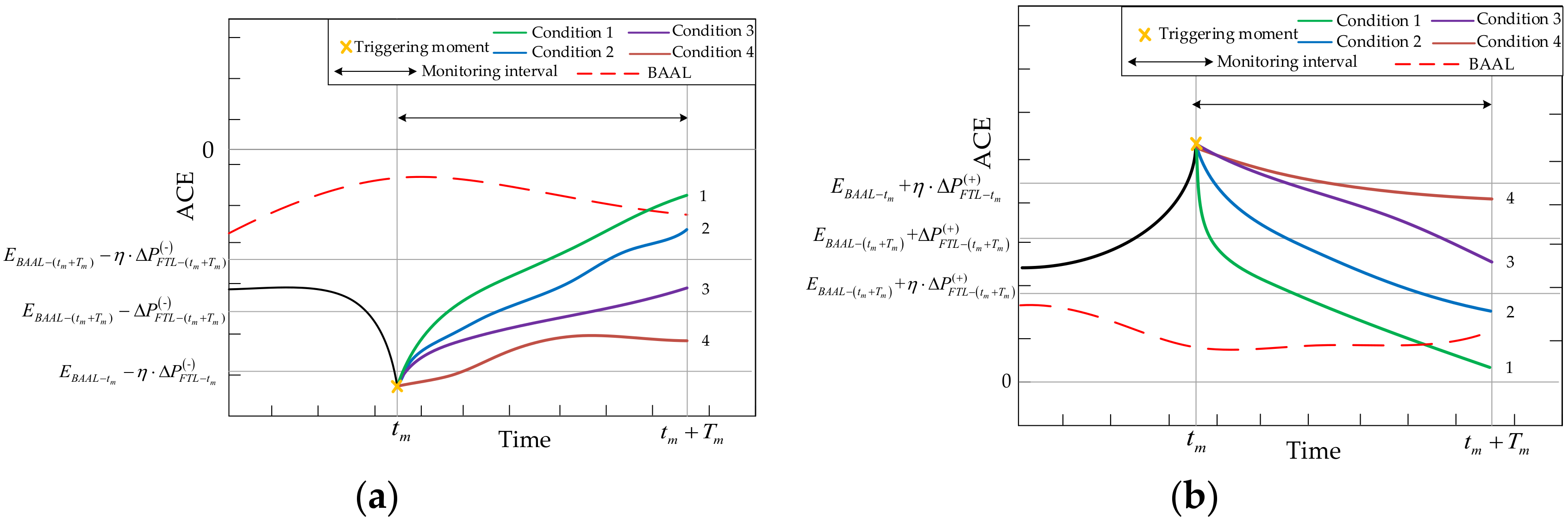
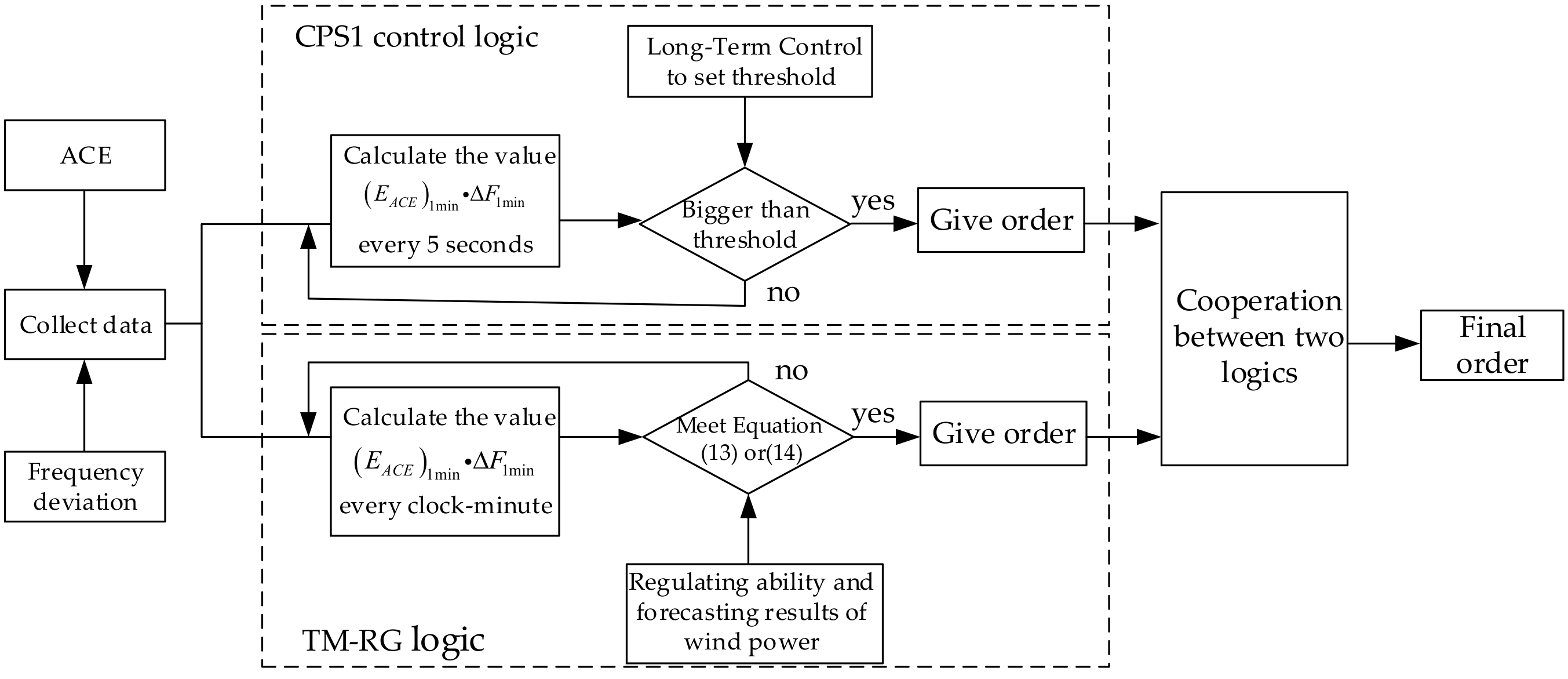

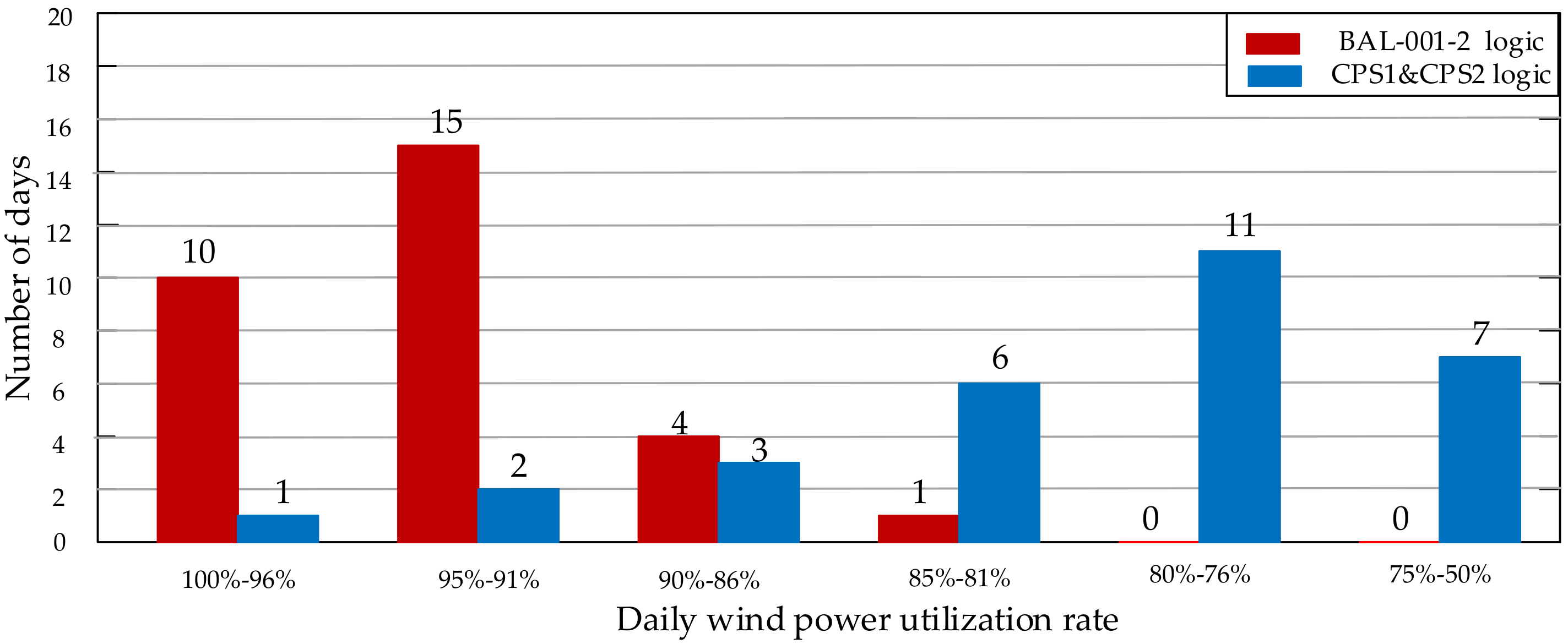

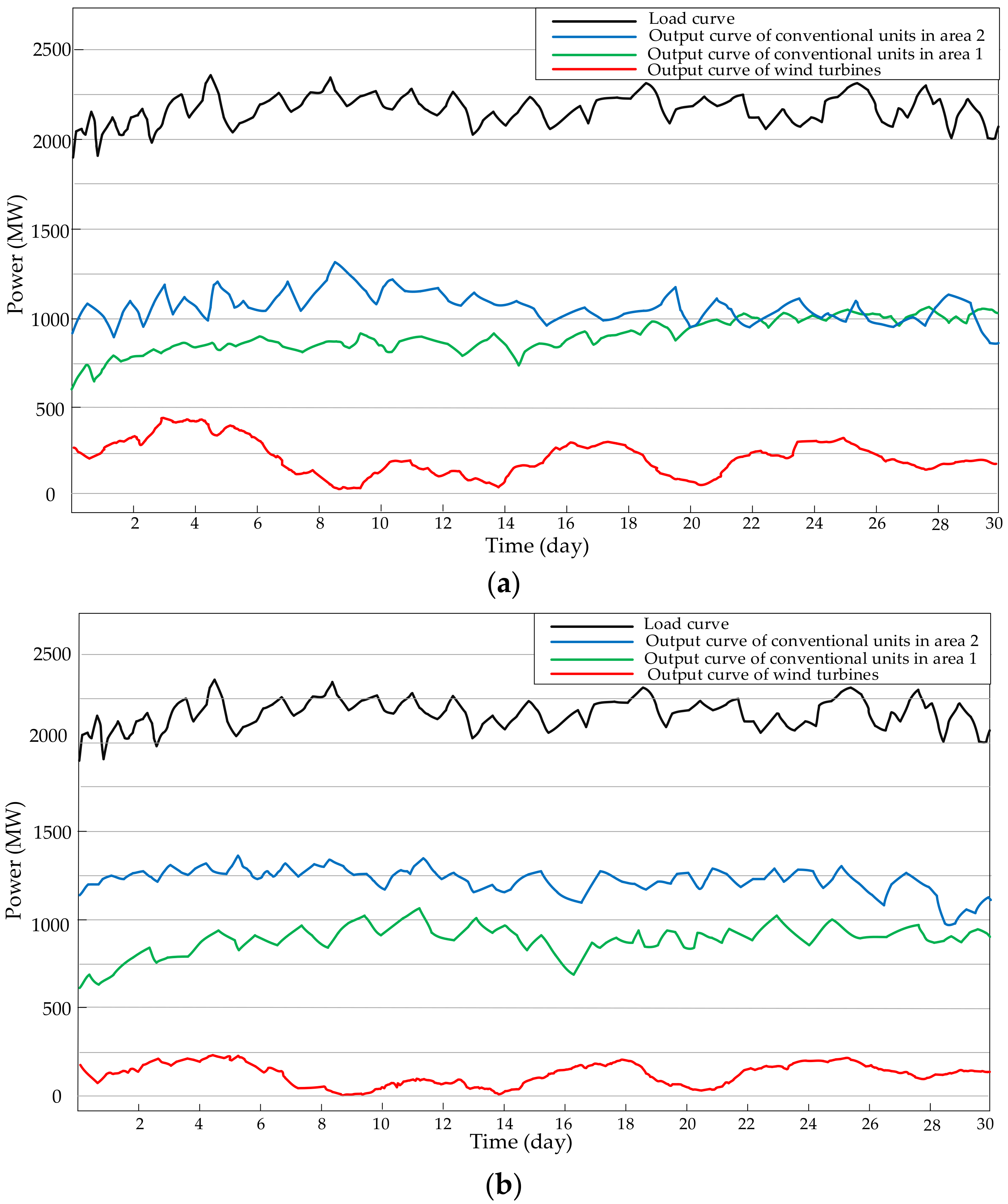
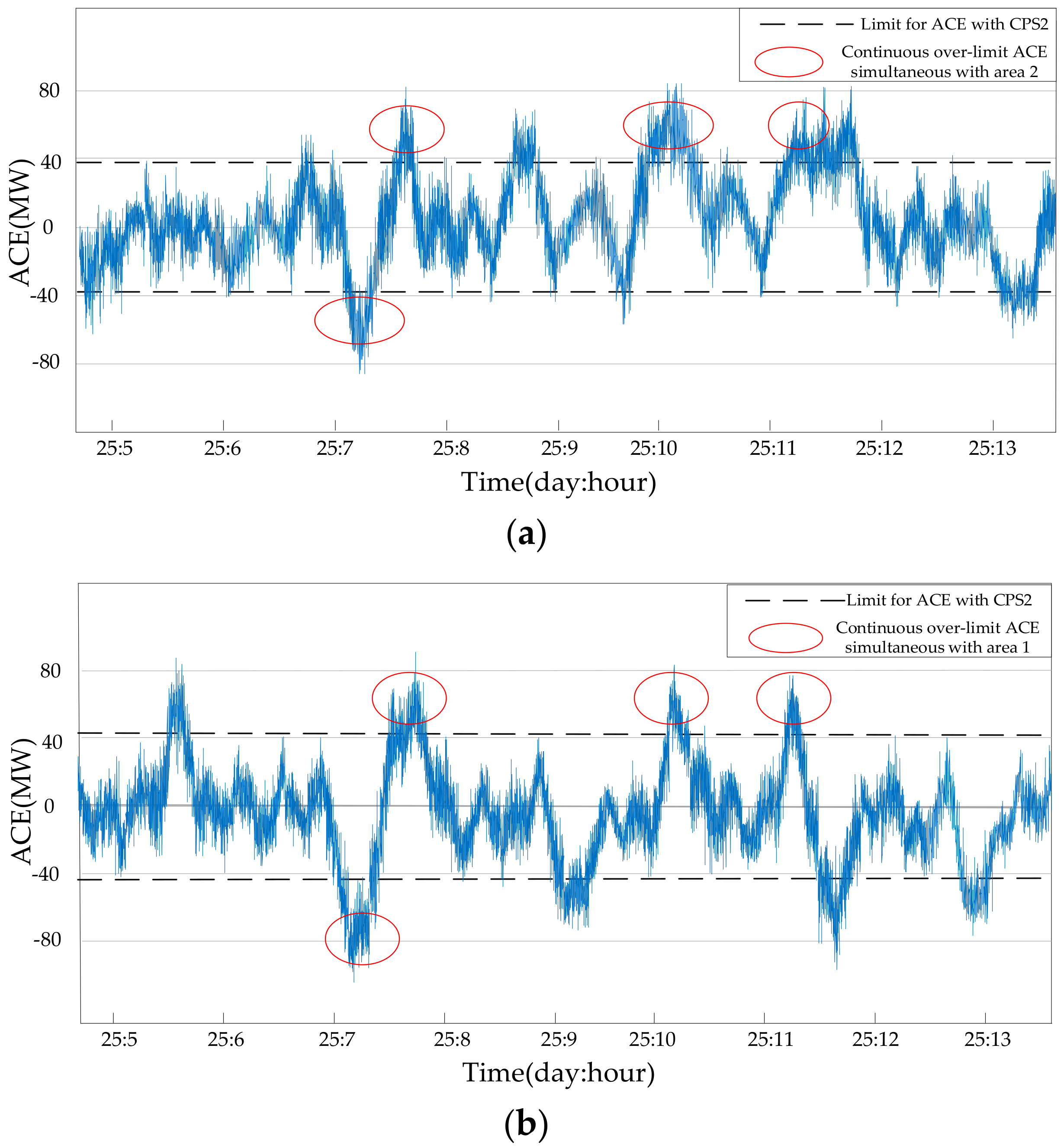
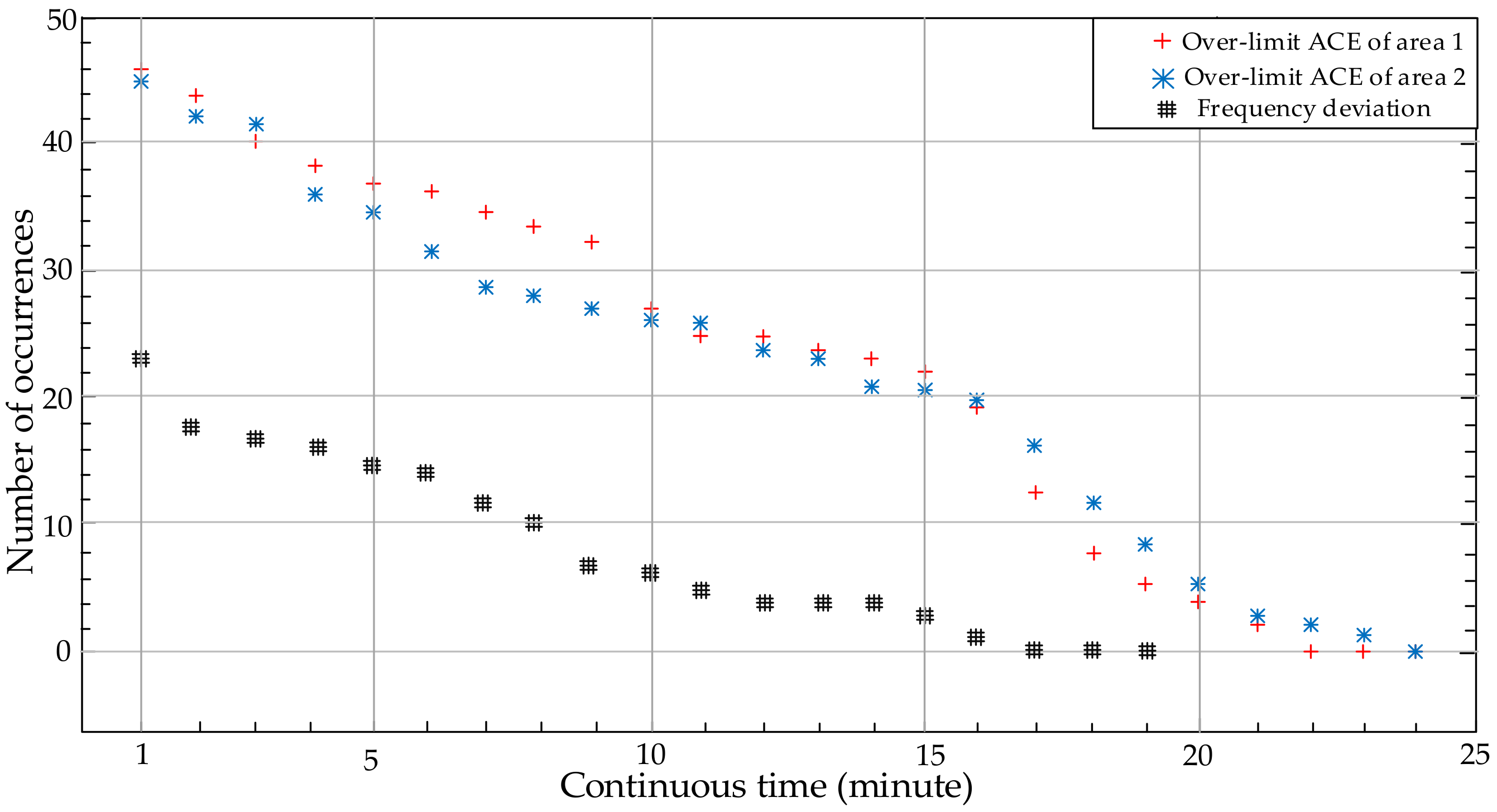
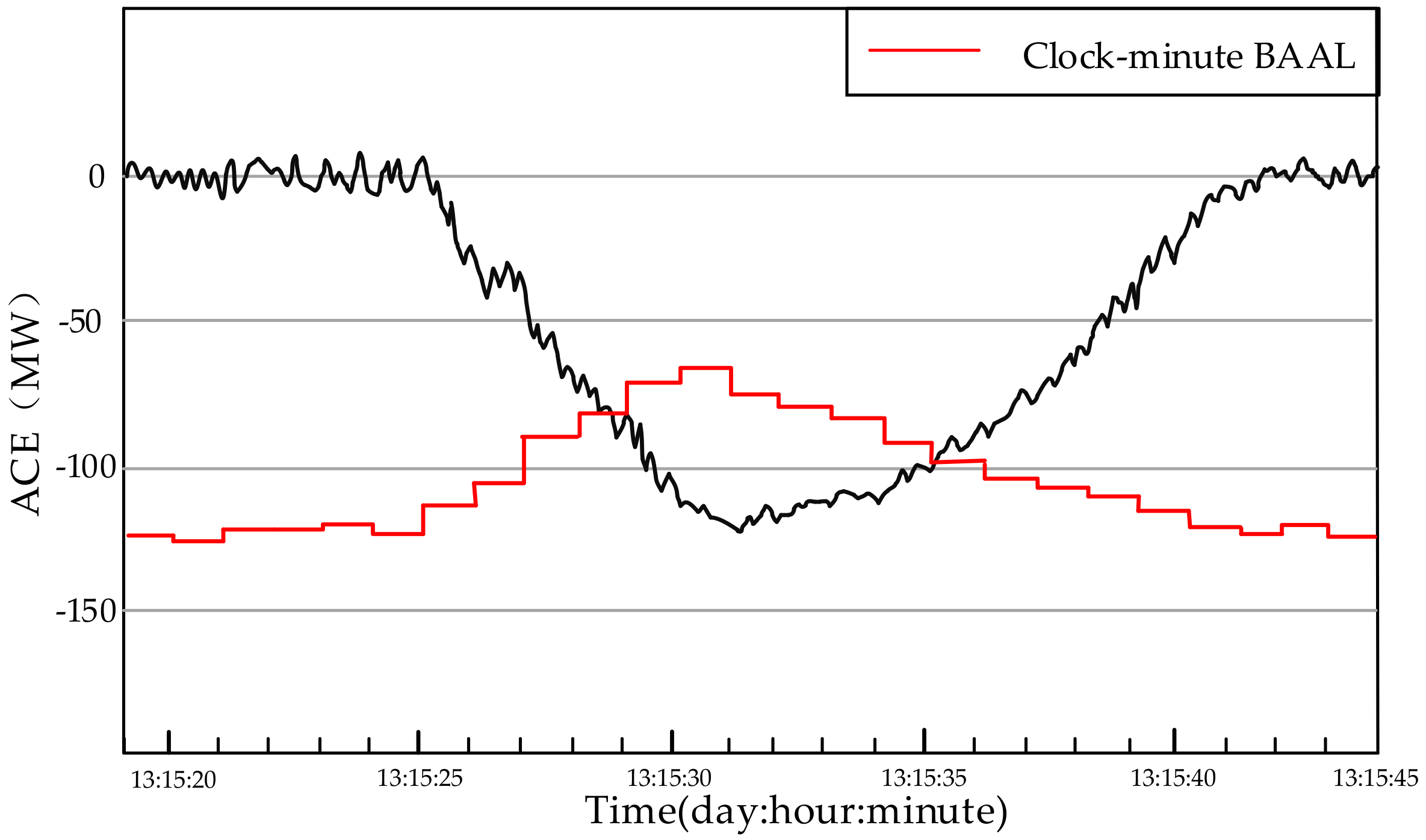
| Violation Level | Description |
|---|---|
| Low | Duration of over-limit ACE is between 30 min and 45 min |
| Moderate | Duration of over-limit ACE is between 45 min and 60 min |
| High | Duration of over-limit ACE is between 60 min and 75 min |
| Severe | Duration of over-limit ACE is larger than 75 min |
| Condition Number | Description of Different Conditions | Control Actions |
|---|---|---|
| 1 | The ACE doses not exceed the BAAL any more. | Clear orders. |
| 2 | Equation (12) or Equation (13) is not met at the end of . ( is replaced by ) | Clear orders and continue monitoring ACE. |
| 3 | Equation (16) or Equation (17) is met at the end of . ( is replaced by ) | Regard as a new triggering moment to give orders. |
| 4 | Equation (18) or Equation (19) is met at the end of . ( is replaced by ) | Regard as a new triggering moment to give orders. Start contingency reserve or cut wind turbines. |
| Parameter | Description | Value |
|---|---|---|
| Scheduled frequency | 50 (Hz) | |
| Target standard deviation of one-minute average frequency deviation | 0.031 (Hz) | |
| Target standard deviation of ten-minute average frequency deviation | 0.0098 (Hz) | |
| Frequency bias coefficients of two areas | , | −150, −200 (MW/0.1 Hz) |
| Total installed capacity of conventional units in two areas | , | 2500, 3500 (MW) |
| Total installed capacity of wind power in area 1 | 500 (MW) | |
| Monitoring interval | 3 (min) | |
| Margin coefficient | 0.9 | |
| Regulating rate of conventional units in area 1 | , | 4% () |
| Regulating rate of conventional units in area 2 | , | 3% () |
| Regulation coefficient, Enhanced regulation coefficient | , | 0.95, 1.2 |
| Type of Control Logic | Monthly Wind Power Curtailment Rate | Average Daily Wind Power Utilization Rate | Number of Times of over-Limit Frequency for over 30 Consecutive Minutes | Monthly Standard Deviation of Frequency Deviation |
|---|---|---|---|---|
| CPS1&CPS2 | 19.6% | 21.8% | 3 | 0.021 (Hz) |
| BAL-001-2 | 6.3% | 7.4% | 0 | 0.028 (Hz) |
© 2018 by the authors. Licensee MDPI, Basel, Switzerland. This article is an open access article distributed under the terms and conditions of the Creative Commons Attribution (CC BY) license (http://creativecommons.org/licenses/by/4.0/).
Share and Cite
Chang, Y.; Liu, R.; Ba, Y.; Li, W. A New Control Logic for a Wind-Area on the Balancing Authority Area Control Error Limit Standard for Load Frequency Control. Energies 2018, 11, 121. https://doi.org/10.3390/en11010121
Chang Y, Liu R, Ba Y, Li W. A New Control Logic for a Wind-Area on the Balancing Authority Area Control Error Limit Standard for Load Frequency Control. Energies. 2018; 11(1):121. https://doi.org/10.3390/en11010121
Chicago/Turabian StyleChang, Yekui, Rao Liu, Yu Ba, and Weidong Li. 2018. "A New Control Logic for a Wind-Area on the Balancing Authority Area Control Error Limit Standard for Load Frequency Control" Energies 11, no. 1: 121. https://doi.org/10.3390/en11010121




